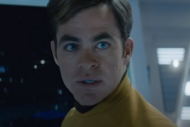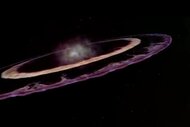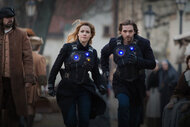Create a free profile to get unlimited access to exclusive videos, sweepstakes, and more!
How Discovery’s big Red Angel twist changes one Star Trek time travel trope

Even before Star Trek: The Next Generation, casual Trek fans knew one truth: Star Trek is not-so-secretly a series about time travel. Arguably the most beloved episode (or movie) in every iteration of the franchise deals with time travel, making any rational person wonder why the franchise isn’t just called Time Trek. With its latest huge twist, Star Trek: Discovery follows the franchise’s tradition of gripping time-travel stories but, smartly, switches things up. This time-travel arc has classic elements, but it’s also decidedly not a classic Star Trek time-travel story.
**SPOILER WARNING: Spoilers ahead for Star Trek: Discovery Season 2, Episode 10, “The Red Angel.”**
At the top of the episode, Discovery pulls a huge fake-out when Tilly says that the bioneural signature of the Red Angel is unequivocally Michael Burnham, implying Michael is time-traveling to save herself. Later, Spock mentions the idea of “the grandfather paradox,” the idea that Burnham had to save herself as a child in the past; otherwise she wouldn’t exist in the future. In a sense, Spock is also describing the “predestination paradox,” because if Burnham had really been the time-traveling Red Angel, she would have created her own future, making time travel her “destiny.”
To date, Trek has included a ton of predestination paradoxes, ranging from huge dramatic arcs to one-off gags. In the TNG episode “Time’s Arrow,” Data is destined to go back in time to 19th-century San Francisco in order to fulfill a paradox involving his head getting severed in his own personal future but, paradoxically, centuries in everyone’s past. In the Star Trek: Deep Space Nine episode “Trials and Tribble-ations,” after time-traveling back to the original USS Enterprise, Dr. Bashir meets a woman who he thinks is a distant relative and worries that he’s part of a predestination paradox and that he might actually be his own grandfather.
But Discovery’s Red Angel red herring inverts some of these classic time-travel tropes in two huge ways.
First, the assumption that the Red Angel tech came exclusively from the future is proven to be untrue. When Leland reveals that Section 31 invented “Project Daedalus” 20 years prior, the Red Angel suit itself is rendered relatively contemporary with the tech of the Discovery era. Second, at the end of the episode, when the Red Angel’s identity is revealed, it’s not Michael Burnham, but rather, Michael’s mom! So, boom, suddenly, there are fewer paradoxes.
The revelation that the Red Angel is Michael’s mother (played by Sonja Sohn) — presumed dead for several decades — actually removes some of the time-travel wonkiness and makes the Red Angel mystery a little less complicated. If the Red Angel’s time-jumping within the Discovery era was only designed to protect Michael Burnham, then a mysterious time-travel story actually just becomes more straightforward: It was mostly a mom protecting her only child. We still don’t know why the Red Angel/Burnham’s mom appeared on 21st-century Earth, nor why she appeared to Spock in the “present.” But the huge majority of the Angel’s time incursions are clearly more about motherly love than saving the galaxy.
Thematically, this is the second way the new Discovery episode inverts the vast majority of Star Trek time-travel stories. While there’s a smattering of Trek time-travel stories in which the act of time travel solves every single problem (Star Trek IV springs to mind), most Trek time travel stories are cautionary tales. Call it “time travel-shaming” if you want, but the “classic” Trek time-travel tale usually presents time travel as something that is more trouble than it's worth.
This is true in two episodes of the '60s show, “Tomorrow Is Yesterday” and, more famously, Harlan Ellison’s “City on the Edge of Forever.” In both cases, traveling back into Earth’s past is either a huge headache that has to be covered up or results in the creation of a terrible parallel timeline in which all the regular characters basically don’t exist.
This finger-wagging time-travel story pops up in The Next Generation era, too. In “Yesterday’s Enterprise” (often considered to be one the best time-travel episodes of Star Trek EVER), just the existence of a time vortex creates a giant, terrible war and turns the Enterprise into a warship instead of a vessel of peace. In Star Trek: Voyager, the very popular episode “Year of Hell” basically has one overriding message: If you don’t want the Year of Hell to happen, stop messing with time travel!
Even in stories like Star Trek: First Contact or the 2009 Star Trek reboot movie, time travel is treated as a mixed bag. Sure, the respective crews in those movies use time travel to solve problems, but in both stories, time travel creates the problem in the first place. If the Borg didn’t have time travel and Nero didn’t fall into Old Spock’s red matter vortex, the conflicts of those movies wouldn’t have happened. Meaning, again, the message is pretty clear: Time travel SUCKS.
So, by making the mysterious time-traveling Red Angel into the hero’s mother, Discovery has flipped the script. Even if various characters try to time travel-shame Burnham’s mother in the next few episodes, the fact that she’s changed the course of history is clearly something the audience will get behind. Because if Burnham's mom didn’t do what she did, clearly Michael Burnham wouldn’t be alive. This time around, time travel isn’t the problem, but possibly the solution.

























